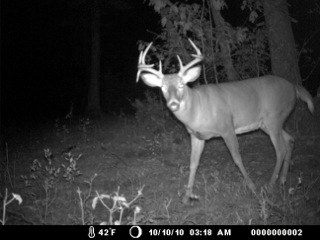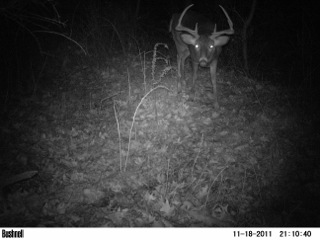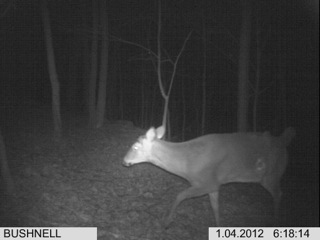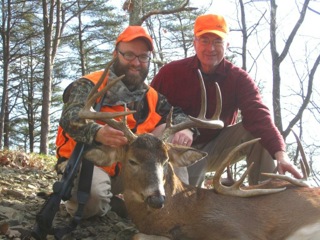“Have you guys seen the buck with the tine that grew down?”
A neighboring property owner posed that simple question to my father in autumn 2010. Quickly, we covered our property in trail cameras hoping to capture a picture of the buck we had already begun calling the Drop Tine Buck. We had close to one trail camera covering every 10 acres and, finally, we were able to capture two pictures of the “buck with the tine that grew down.”
By Garrett Boop
He appeared to be 2.5 years old at the time. Although we make it a practice to protect young bucks, he would have been hard to pass had he walked by one of our stands that fall. Fortunately, he successfully avoided us all season. In fact, those two pictures were the only evidence he even existed.
Autumn 2011 brought high anticipation the Drop Tine Buck would have grown another drop tine, or maybe two. In the heat of early July, we covered the farm in trail cameras as the bucks were growing their velvet antlers.
One summer night while fighting mosquitos and filming deer feeding on green soybeans, I caught a glimpse of a buck with a familiar rack shape, but no visible drop tine. Our trail cameras confirmed it was him. The Drop Tine Buck had survived the heavy pressure of the 2010 Pennsylvania deer season and was alive and well. However, he did not grow a drop tine in 2011. He had two visible bumps on the undersides of his main beams but no measurable drop tine.
He was a great deer at 3.5 years old and I would have been more than happy to put my tag on him. We spent a lot of time sitting in trees during early archery season with high hopes he would walk past. He managed to avoid us during the early archery season, spending most of his time on the neighbor’s sanctuary of posted non-hunted land.
As rifle season opened, we hoped he would make a mistake we could capitalize on. He did slip up during rifle season, possibly chasing a doe during daylight, which led him on a path directly in front of one of our neighbors hoping for the same scenario. After a long tracking job across our property, the shot proved to be non-lethal and the neighbor was unable to recover the Drop Tine Buck. As imagined, we feared the worst.
A glimmer of hope came when I checked one of my Trophy Cams in early January. The camera had captured a few pictures of a big buck with no antlers and a wound just in front of his hind quarters. Besides the wound and shedding his antlers early, the buck appeared to be healthy. Hope still existed.
When late season muzzleloader opened in Pennsylvania, I spent some time on the farm hoping to fill a remaining antlerless tag. One afternoon as I was sneaking in to a ladder stand over a frosty clover plot, I almost stepped on a shed antler. Since it was early January, I was surprised to find a freshly dropped antler.
I was even more surprised when I realized it was the right side of the Drop Tine Buck. The inward curved tines, swept back main beam, coupled with the numb on the bottom of the thick main beam were unmistakable. I was distracted the entire evening thinking about the Drop Tine Buck and wondering where his other shed might be and, most importantly, if he was still alive. After some zig-zag laps through the clover plot the following morning, I stumbled upon his other shed antler. The sheds fell about 75 yards from each other. The first one was only about 50 yards from where the Trophy Cam had captured pictures of the wounded buck. It goes without saying, I was excited to have the antlers from such an incredible buck.
Finding both sheds was not the last time I would have contact with the Drop Tine Buck during the 2011 season. On the last day of the late muzzleloader season, we decided to invite some friends to put on little pushes to try to shoot some more doe before the season ended. I carried the freshly shed antlers with me that morning and informed the group of the shed buck and my fears he would be killed as a doe as we tried to thin out a few deer from the property.
As I crept through the cover on a south facing pine ridge on the first push of the day, I noticed a big set of white ears. Those white ears were attached to a large deer laying underneath a white pine tree. It was him; I knew it right away. The big blocky head and large white exposed pedicles gave him away. He saw me at almost the same time
I tried my best to back away and not kick him out of his bed. I did not want to take the chance of somebody shooting him as a doe. My intrusion into his bedroom proved to be too much for him. He got up and headed towards one of our neighbors positioned just outside of the cover in a likely escape route. Keith saw the deer headed his way and quickly surmised, due to his sheer size, it was the shed buck we talked about that morning. He let him slip back into the cover unharmed.
As we left the property on the last day of muzzleloader season, marking the end of the 2011 Pennsylvania deer season, I felt a sense of guilt for bumping him out of his bed. To make matters worse, he did not show up on any trail cameras during the late winter and we were left fearing the worst again.
June 2012 found me anxious to get the trail cameras out and see if he was still alive. Even with my eagerness every year to see what bucks made it through the winter, spring, and early summer, I try to wait until the first week of July to hang trail cameras in the woods. By early to mid-July, the bucks have grown most of their antlers and their racks start to take their final shape. My impatience got the best of me and before the calendar turned to July, I had 12 trail cameras in the woods.
The Drop Tine Buck did not show up on any of the cameras and we did not see him during early archery season, despite our best efforts to stay out of the area we believed was his core home range unless the conditions were perfect Everything changed the last Friday of archery season; the Drop Tine Buck finally showed up on a trail camera.
There were only three pictures of him. Two were blurry and were taken in the middle of the night two weeks prior, but it was, without a doubt, him. His body had grown, but his antlers looked very similar to the previous year. A 4.5-year old buck in Pennsylvania is truly an incredible sight, even if it was only in a picture captured a half hour after midnight.
I discovered the pictures on the eve of the last day of early archery season. The next afternoon I found myself leaning against an oak tree a mere 50 yards from the spot the camera had captured him. As I shifted from foot to foot, my thoughts were consumed with images of the Drop Tine buck stepping onto one of the trails that would bring him into bow range. As much as I tried, I could not will him into view that evening before the sun crept below the horizon and marked an end to the Pennsylvania early archery season. Although he had now successfully weathered four complete hunting seasons, I knew he would see some more pressure during the upcoming two-week rifle season.
The first morning of the 2012 Pennsylvania rifle season brought cold weather, a few doe sightings, and a far off glimpse of a bobcat. As a standing tradition, my father and brothers gathered for an early lunch and laid out the final plans for some small pushes in the afternoon. My father grew up drive hunting in the Pennsylvania mountains and our little group of six guys has seen a lot of success pushing small woodlots and briar patches during the two-week rifle season. We have found that bucks, and deer in general, tend to crawl into the nearest available cover as the woods fill with orange vests and the first shots ring out, even if that cover might look like a briar patch rabbits would call home.
The first push found me anxiously leaning against a maple tree at the edge of some thick bedding cover. This bedding area was in what I had surmised was the Drop Tine Buck’s core area. In fact, I was standing less than 150 yards from where I had walked up on him in his bed during the winter of 2011. The majority of the trail camera pictures of him were from this area as well. As my brothers and father slowly made their way through the cover on the southernly exposed pine ridge, deer started to move my way.
As he stepped into view, I knew right away it was the Drop Tine Buck. He was huge. As a mature 4.5-year old buck, he made the young deer standing next to him appear to be a wobbly fawn. He paused at the edge of the thick cover hoping to find a new place to hide, but his next two steps brought him into the opening I needed. I eased off the safety and took careful aim before squeezing the trigger. After the shot, he only took a few steps before taking his last breath.
I was not the first person to stand next to him. My brother-in-law was the first on the scene and, fittingly, he had been on this three-year quest as well. He yelled to me something I already knew: “It’s him! It’s the Drop Tine Buck!”
As I kneeled next to him, the feeling was bittersweet as I knew the journey had come to an end. I was finally able to put my tag on the Drop Tine Buck. Hunting him for three years was an experience I will not soon forget. He was an incredible animal and I am a better hunter having chased him through the woods of Pennsylvania.
+++
Keep Up With Your Deer Throughout The Year!
 Cuddeback’s Seen camera features ½ second trigger speed and Zone Control detection, allowing you to choose wide angle or centered subject mode. Choose camera delays from 1 second to 3 minutes. Seen operates on 8 AA batteries for up to six months and, thanks to it’s small size, is ideal for trails, rub lines and scrapes.
Cuddeback’s Seen camera features ½ second trigger speed and Zone Control detection, allowing you to choose wide angle or centered subject mode. Choose camera delays from 1 second to 3 minutes. Seen operates on 8 AA batteries for up to six months and, thanks to it’s small size, is ideal for trails, rub lines and scrapes.
You’ll get clear, crisp native 5MP images with Seen. Correctly Exposed IR Technology means reduced flash washout and consistently even IR illumination. Smart Color Technology means superior color saturation and vibrant colors. Seen can also be set to take 10, 20, or 30 second videos, day, night or both. Check It Out Here Now!












